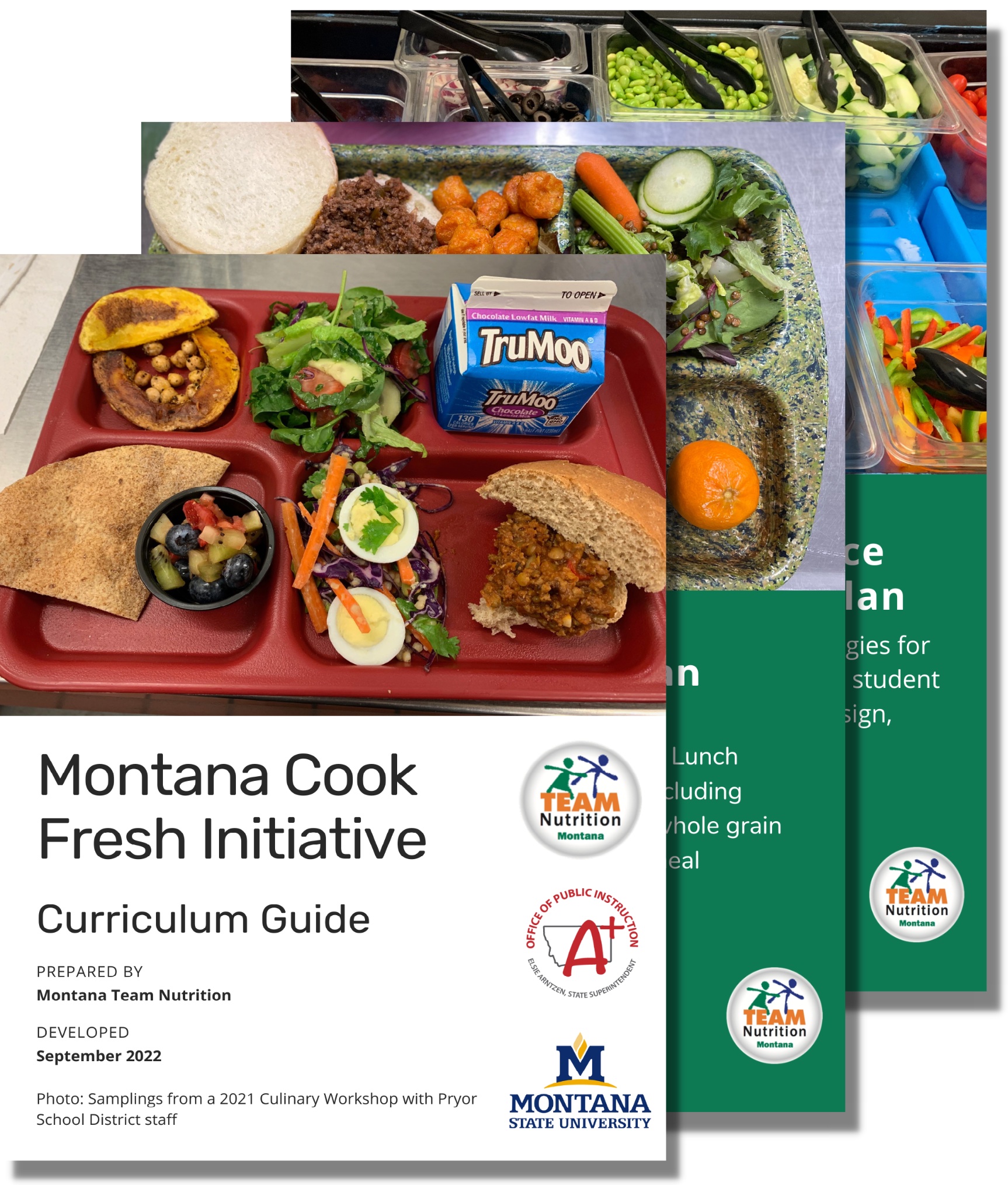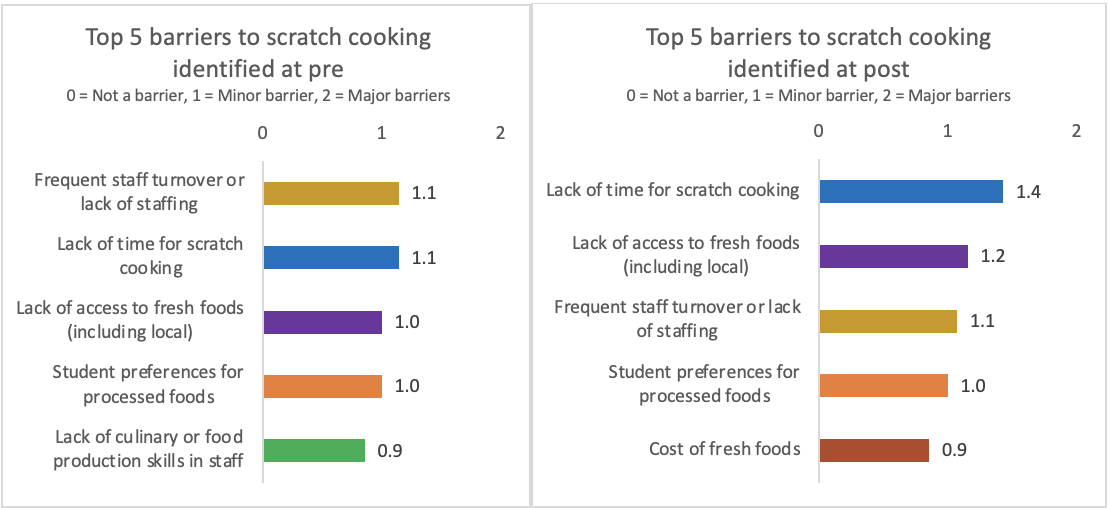Montana Cook Fresh Initiative Curriculum
About the Montana Cook Fresh Initiative
Serving high quality school meals matters. School meals influence the health and wellbeing of over 30 million students every day across the United States through United States Department of Agriculture (USDA) Child Nutrition Programs. Student’s perceptions of school meals are especially impacted by the attractiveness of the foods available on the serving line, and their access to fresh foods. This comprehensive training program was developed and tested as part of the Montana’s Office of Public Instruction’s innovative plan to support Montana school districts in serving high quality meals, called the Montana Cook Fresh Initiative (MCFI). Montana Team Nutrition defines high quality school meals as fresh “from scratch” school meals that appeal to Montana students, incorporate local and USDA foods, and meet USDA nutrition standards.

Who is the target audience of this curriculum?
This curriculum is designed to reach three levels of school nutrition professional staff, including directors, managers, and frontline staff. The lesson plans are created for school nutrition programs that are operating USDA Child Nutrition Programs, including the National School Lunch Program and School Breakfast Program.
What is included in this curriculum?
This curriculum includes 10 lesson plans developedfor all staffing levels to increase the knowledge, skills, and self-efficacy in preparing USDA compliant, scratch cooked meals. It also includes the evaluation package for the initiative, resources for peer education, tips for adapting the lesson plans into various delivery methods, 30 school nutrition recipes and more.
What was the impact of the Montana Cook Fresh Initiative?
Montana Team Nutrition evaluated the impact and effectiveness of the Montana Cook Fresh Initiative and its curriculum by conducting a pre and post evaluation from the 19 participating school nutrition programs. The school nutrition programs were sorted into two Cohorts (C1=9; C2=10). Cohort 1 pre-assessments were collected between March – July 2021 (n=8) and (n=8) post evaluations were collected from November 2021–January 2022. Pre-assessments for Cohort 2 (n=6) were collected between March – June 2021, with post evaluations collected from February to June 2022 (n=6). Table 1 summarizes the various training interventions and reach of the Initiative. The lesson plans associated with these training interventions make up the core of the Montana Cook Fresh Initiative Curriculum Guide.Statistical analysis of the pre and post assessments included descriptive statistics (mean, standard deviation, and percent change) and Chi testing for categorical variables, significant when p < 0.05.
Table 1. Montana Cook Fresh Initiative Training Intervention Summary, 2020-2022

Evaluation Results
This Initiative was undertaken at a time when school nutrition programs were facing dramatic disruptions to typical program operations, putting a great deal of stress on individuals and systems across the country. Even through the challenges of staffing shortages, an unreliable supply chain, and greater meal demand, the programs that participated in this Initiative made statistically significant improvements to the frequency that they offered scratch cooked entrees from pre to post (p = 0.04). The percentage of food service programs offering from scratch lunch entrees on a weekly basis increased from 35.7% at pre to 85.7% at post (Chart 1).
Chart 1. Change in Frequency of Lunch Entrees Prepared from Scratch from Pre to Post Montana Cook Fresh Initiative, N=14, 2020-2022

This Initiative may have also reduced barriers to scratch cooking through training interventions; lack of culinary or food production skills in staff was identified as top barrier to scratch cooking at pre but was no longer in the top five barriers to scratch cooking at post (Chart 2).
Chart 2. Top 5 Barriers to Scratch Cooking from Pre to post Montana Cook Fresh Initiative, n=14, 2020-2022

COVID-19 made it challenging for schools to reduce the frequency that they served Ready to Serve Foods; pre-packaged foods were an important and useful tool for alternative meal service like grab-n-go and meals in the classroom. Supply chain issues also made it difficult for schools to reliably order and receive products, making some Ready to Serve foods a more convenient option. Despite this challenge, the evaluation results indicate that even if schools served more Ready to Serve Foods overall, they also served more fresh or whole foods. Across all of the programs that participated in this Initiative, Fresh Food Scores increased by 15.01%.
Chart 3. Percent Change in Food Frequency Scores from Pre to Post Montana Cook Fresh Initiative, N=14, 2020-2022

This training Initiative also focused on helping schools implement overall program best practices that support compliance with USDA Child Nutrition Program regulations and efficient program operation. From pre to post, the programs that participated in this Initiative had a statistically significant (p = 0.002) increase in agreement with implementing these best practices.
Challenges Encountered
Like all areas of life, COVID-19 impacted grant activities and data collection plans. Modifications to activities included the cancellation of certain trainings, decreased number of regional workshops, modification of training delivery methods, decreased number of on-site peer education visits, and a new informal virtual technical assistance opportunity. It prohibited collection of student data to measure student perceptions of school meals and average daily participation. It also created major barriers to collecting the evaluation data. Another challenge was high staff turnover in the multiple positions in the school nutrition programs. Increased stress from the challenges encountered by the school nutrition program staff impacted their ability to follow through and attend the planned training courses in the Initiative.
Best Practices Learned
Montana Team Nutrition developed many best practices as a part of this training program, including:
- Offering a variety of trainings in a variety of formats
- Prioritizing engagement especially in virtual formats
- Simplified evaluation collected at the time of the training
- Offering virtual peer education in individual and group settings
- In person is the best option for culinary trainings
For a detailed exploration of best practices related to implementing the Montana Cook Fresh Initiative, download the Montana Cook Fresh Initiative Curriculum Guide!
Acknowledgements
This Montana Cook Fresh Initiative was developed using funds from the 2019 Team Nutrition Training Grant for Innovative State Training Programs awarded to the Montana Office of Public Instruction. Thank you to all of the school nutrition programs that participated in this program – your hard work and dedication over the last few years did not go unnoticed. Thank you to the Montana Office of Public Instruction School Nutrition Programs State Agency staff for their tireless work to support schools during a challenging time. For a full evaluation report on this project, please contact Molly Stenberg at stenberg@montana.edu.
About USDA Team Nutrition
To learn more about Team Nutrition visit: https://www.fns.usda.gov/tn/about-team-nutrition or to access resources, visit: https://www.fns.usda.gov/tn/school
